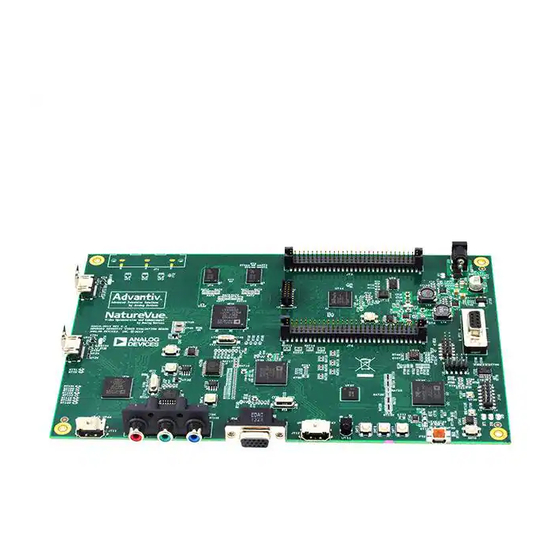
Analog Devices ADV8003 Manuals
Manuals and User Guides for Analog Devices ADV8003. We have 1 Analog Devices ADV8003 manual available for free PDF download: Hardware Manual
Analog Devices ADV8003 Hardware Manual (440 pages)
Video Signal Processor with Motion Adaptive Deinterlacing, Scaling, Bitmap OSD, Dual HDMI Tx and Video Encoder
Brand: Analog Devices
|
Category: Signal Processors
|
Size: 6 MB
Table of Contents
-
-
-
Overview15
-
-
-
-
Mode 171
-
Mode 273
-
Mode 374
-
Mode 475
-
Mode 576
-
Mode 677
-
Mode 778
-
Mode 879
-
Video Muxing85
-
TTL Output91
-
RX Input Channel105
-
Frame Tracking112
-
DDR2 Interface113
-
SPI Loop through119
-
VBI Data Delay121
-
Resets122
-
AV-Codes125
-
-
-
Introduction144
-
Primary VSP144
-
Frame Latency151
-
Game Mode153
-
Low Latency Mode154
-
VIM Cropper156
-
Pixel Packer159
-
Scaler Controls159
-
Pixel Unpacker161
-
VOM Cropper161
-
Motion Detection163
-
CUE Correction166
-
Scaler170
-
Panorama Mode172
-
Output Port173
-
Demo Function177
-
Secondary VSP180
-
Frame Latency187
-
VIM Cropper189
-
Scaler191
-
Panorama Mode193
-
Pixel Packer194
-
Pixel Unpacker195
-
VOM Cropper195
-
Output Port197
-
DDR Bypass Mode201
-
-
Bootup Protocol202
-
Reboot Protocol203
-
VOM Set Protocol206
-
-
-
-
Introduction208
-
-
Introduction209
-
OSD Blending210
-
OSD Core211
-
OSD Color Space213
-
OSD Timers213
-
OSD Scaler217
-
Overview218
-
-
-
Detect227
-
AV Mute Status229
-
Video FIFO230
-
Pixel Repetition232
-
-
Packet Registers239
-
-
-
-
General Controls246
-
Reset Strategy247
-
AV Mute248
-
Spare Packets250
-
Input Format253
-
Video Setup253
-
Pixel Repetition255
-
AVI Infoframe256
-
MPEG Infoframe257
-
Gamut Metadata258
-
Audio Setup260
-
I2S Audio263
-
SPDIF Audio270
-
DSD Audio271
-
HBR Audio271
-
CTS Parameter273
-
N Parameter273
-
ACP Packet280
-
Audio Infoframe280
-
ISRC Packet281
-
EDID Definitions283
-
EDID Handling283
-
Reading the EDID283
-
HDCP Handling285
-
AV Mute290
-
-
-
-
Main Controls294
-
Receive Buffers297
-
-
8 Video Encoder
307-
Introduction307
-
-
Filters315
-
SD Filters315
-
ED/HD Filters318
-
Double Buffering326
-
Gamma Correction329
-
Coring Gain Data340
-
Border Area341
-
DNR Threshold341
-
DNR Mode Control342
-
-
-
9 Interrupts
349-
Interrupt Pins349
-
-
Introduction350
-
-
HDMI Tx Core356
-
-
Appendix A
358 -
Appendix B
363 -
Appendix D
402-
Unused Pin List403
-
-
Appendix E
403 -
Appendix F
416
-
List of Figures
431-
List of Tables
435 -
Revision History
438
-
Advertisement
